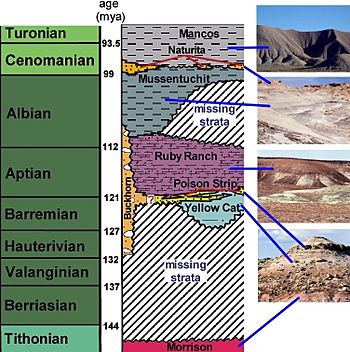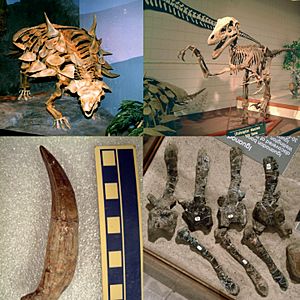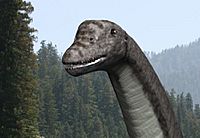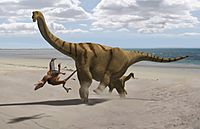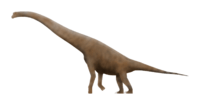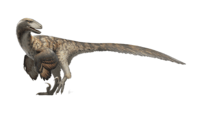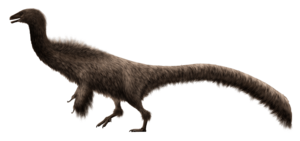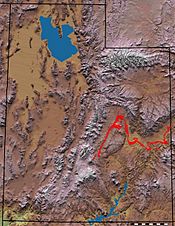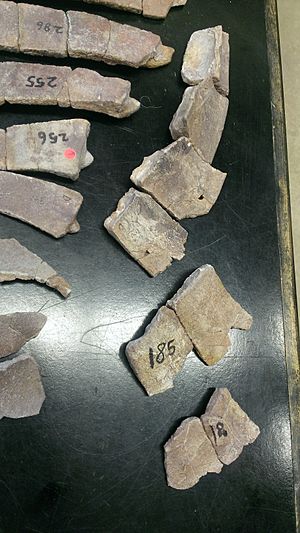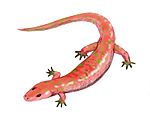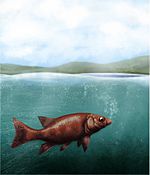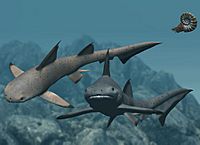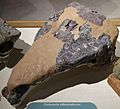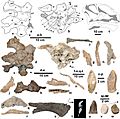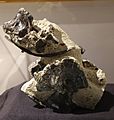Cedar Mountain Formation facts for kids
Quick facts for kids Cedar Mountain FormationStratigraphic range: Late Berriasian-Cenomanian ~140–95Ma |
|
|---|---|
| Type | Geological formation |
| Unit of | Dakota Group |
| Sub-units | See text |
| Underlies | Naturita Formation |
| Overlies | Morrison Formation |
| Thickness | Varies, some sections over 1000 metres |
| Lithology | |
| Primary | Conglomerate, sandstone, mudstone |
| Location | |
| Coordinates | 39°15′00″N 110°49′05″W / 39.250°N 110.818°W |
| Approximate paleocoordinates | 40°12′N 69°00′W / 40.2°N 69.0°W |
| Region | |
| Country | |
| Type section | |
| Named for | Cedar Mountain |
| Named by | Stokes |
| Year defined | 1944 |
The Cedar Mountain Formation is a special type of rock layer found in eastern Utah. It's named after Cedar Mountain, where it was first studied in 1944 by William Lee Stokes. This formation is important because it holds many fossils, especially dinosaurs, from a time long ago.
Contents
What is the Cedar Mountain Formation?
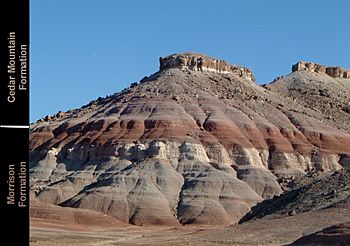
This rock formation is made of sediments that were laid down on land, not in the ocean. Imagine ancient rivers, lakes, and floodplains – that's where these rocks formed! Scientists believe the Cedar Mountain Formation was created during the last half of the Early Cretaceous period, about 127 to 98 million years ago. We know this thanks to radiometric dating, which is a way to figure out the age of rocks using natural radioactivity.
The Cedar Mountain Formation sits between two other rock layers: the Morrison Formation below it and the Naturita Formation above it.
Layers of the Formation
The Cedar Mountain Formation is made up of several smaller layers, called "members." Scientists sometimes disagree on whether there are four or five members. Most agree that the Buckhorn Conglomerate is the very bottom layer. Above it are the Yellow Cat Member, Poison Strip Sandstone, Ruby Ranch Member, and the Mussentuchit Member. Each of these layers tells us something different about the ancient environment.
Buckhorn Conglomerate
This is the lowest layer of the Cedar Mountain Formation. It's named after the Buckhorn Reservoir. It's made of conglomerate, which is rock made of rounded pebbles and stones cemented together.
Yellow Cat Member
This layer is named after the Yellow Cat mining area, near Arches National Park. It's mostly made of dull gray mudstones, which are rocks formed from ancient mud. These mudstones show signs of old soils, meaning the area was once a floodplain with rivers. This layer is thought to be about 140 to 133 million years old.
Poison Strip Sandstone
Named for the Poison Strip uranium area, this layer has prominent sandstone cliffs. It formed from ancient river channels, with some mud and limestone from floodplains and small ponds. This layer is famous for "Tony's Bone Bed."
- Tony's Bone Bed: This is a very important spot where many dinosaur bones were found in 1998. The bones were not connected, and some looked like they had been trampled or chewed by scavengers. This suggests the bones gathered slowly over time, perhaps during dry seasons when river water was low.
Ruby Ranch Member
This is the most widespread and easy-to-spot layer of the Cedar Mountain Formation. It's named after the Ruby Ranch. It's mostly maroon-colored mudstones with round, hard lumps called carbonate nodules. These nodules formed in ancient soils during a time when the climate was dry with strong seasons. The rivers in this period flowed northeast, towards an ancient sea.
Mussentuchit Member
This is the top layer of the Cedar Mountain Formation, named after Mussentuchit Wash. It's mostly gray mudstones with lots of fossilized plant material and volcanic ash. This suggests it was a wet coastal plain with plenty of rain. This layer is about 104 to 98 million years old.
Fossils Found Here
The Cedar Mountain Formation is a treasure chest of Early Cretaceous fossils, especially dinosaurs! Scientists have only really started studying these fossils since the 1990s. The discoveries here are helping us understand how dinosaurs changed over time and how the North American continent moved.
Dinosaurs
Scientists have found at least two, and possibly three, different groups of dinosaurs in the Cedar Mountain Formation.
The older dinosaurs, found in the Yellow Cat, Poison Strip, and lower Ruby Ranch layers, include dinosaurs like Nedcolbertia (a small meat-eater) and Cedarosaurus (a long-necked plant-eater). Other dinosaurs like the armored Gastonia and an unnamed iguanodontid are similar to dinosaurs found in England from the same time. This tells us that North America and Europe were still connected back then.
However, the younger dinosaurs, found in the upper Ruby Ranch and Mussentuchit layers, are more like dinosaurs found in Asia! For example, the armored Cedarpelta is related to dinosaurs from Mongolia. This shows that as the North American continent drifted westward, it eventually connected with Asia, bringing new types of dinosaurs. This upper group also includes early tyrannosaurs, ceratopsians (horned dinosaurs), and pachycephalosaurs (dome-headed dinosaurs).
Armored Dinosaurs (Ankylosaurs)
| Armored Dinosaurs from the Cedar Mountain Formation | ||||||
|---|---|---|---|---|---|---|
| Genus | Species | Member | What was found | Notes | Images | |
| Animantarx | Animantarx ramaljonesi | Mussentuchit Member | Part of a skull and skeleton. | |||
| Cedarpelta | Cedarpelta bilbeyhallorum | Mussentuchit Member | Skull and body bones. | |||
| Gastonia | Gastonia burgei | Upper Yellow Cat Member | Two skulls, two partial skulls, and four or five partial skeletons. | |||
| G. lorriemcwhinneyae | Ruby Ranch Member | |||||
| Peloroplites | Peloroplites cedrimontanus | Mussentuchit Member | ||||
| Sauropelta | Indeterminate | Ruby Ranch Member | ||||
Beaked Dinosaurs (Neornithischians)
| Beaked Dinosaurs from the Cedar Mountain Formation | ||||||
|---|---|---|---|---|---|---|
| Genus | Species | Member | What was found | Notes | Images | |
| Cedrorestes | Cedrorestes crichtoni | Upper Yellow Cat Member | ||||
| Eolambia | Eolambia caroljonesa | Mussentuchit Member | ||||
| Hippodraco | Hippodraco scutodens | Upper Yellow Cat Member | ||||
| Iguanacolossus | Iguanacolossus fortis | Lower Yellow Cat Member | ||||
| Iguanodon | Iguanodon ottingeri | Teeth. | Doubtful. | |||
| Planicoxa | Planicoxa venenica | Poison Strip Member | Connected body bones. | |||
| Tenontosaurus | Tenontosaurus tiletti | Mussentuchit Member | Most common beaked dinosaur in the area. | |||
| Indeterminate | Ruby Ranch Member | Most common beaked dinosaur in the area. | ||||
| Zephyrosaurus | Zephyrosaurus schaffi | Mussentuchit Member | ||||
Long-necked Dinosaurs (Sauropods)
| Long-necked Dinosaurs from the Cedar Mountain Formation | ||||||
|---|---|---|---|---|---|---|
| Genus | Species | Member | What was found | Notes | Images | |
| Abydosaurus | Abydosaurus mcintoshi | Mussentuchit Member | ||||
| cf. Astrodon | Indeterminate | Ruby Ranch Member. | ||||
| Brontomerus | Brontomerus mcintoshi | Ruby Ranch Member | ||||
| Cedarosaurus | Cedarosaurus weiskopfae | Upper Yellow Cat Member | Body skeleton. | |||
| Mierasaurus | Mierasaurus bobyoungi | Lower Yellow Cat Member | ||||
| Moabosaurus | Moabosaurus utahensis | Poison Strip Member | Remains of at least 18 partial individuals. | |||
| Venenosaurus | Venenosaurus dicrocei | Poison Strip Member | Partial body skeleton. | |||
Meat-eating Dinosaurs (Theropods)
| Meat-eating Dinosaurs from the Cedar Mountain Formation | ||||||
|---|---|---|---|---|---|---|
| Genus | Species | Member | What was found | Notes | Images | |
| cf. Acrocanthosaurus | Indeterminate | Ruby Ranch Member. | ||||
| Deinonychus | Indeterminate | Mussentuchit Member. | ||||
| Falcarius | Falcarius utahensis | Lower Yellow Cat Member. | ||||
| Geminiraptor | Geminiraptor suarezarum | Lower Yellow Cat Member. | ||||
| Martharaptor | Martharaptor greenriverensis | Upper Yellow Cat Member. | ||||
| Moros | Moros intrepidus | Mussentuchit Member. | ||||
| Nedcolbertia | Nedcolbertia justinhofmanni | Upper Yellow Cat Member. | Partial skeletons of three individuals. | |||
| cf. Richardoestesia | Indeterminate | Mussentuchit Member. | ||||
| Siats | Siats meekerorum | Mussentuchit Member. | Partial body skeleton of a young individual. | |||
| Utahraptor | Utahraptor ostrommaysi | Upper Yellow Cat Member. | Skull and body fragments. | |||
| Indeterminate | Poison Strip Member. | |||||
| Yurgovuchia | Yurgovuchia doellingi | Lower Yellow Cat Member. | ||||
Other Fossils
Besides dinosaurs, the Cedar Mountain Formation has many tiny fossils, mostly teeth from different animals. These "microfossils" are found by washing rock through screens.
- Fish: Scientists have found teeth from ancient freshwater sharks (like Hybodus), rays, lungfish (Ceratodus), and other bony fish. Lungfish are cool because they can breathe air when water has low oxygen!
- Amphibians: Some salamanders and frogs have been found, but they are rare.
- Reptiles: Many reptile fossils are present, including aquatic turtles (Glyptops, Naomichelys), at least one type of snake (Coniophis), and several different lizards. Crocodiles are also found, but only in pieces. There's even a fragment of a large flying reptile called a pterosaur.
- Birds: Bird fossils are very rare because their bones are delicate. At least one ancient aquatic bird has been found.
- Mammals: Many small mammal fossils have been discovered, including early types of mammals like triconodonts, symmetrodonts, multituberculates, and even one of the earliest marsupials (Kokopellia).
Other types of fossils include:
- Charophytes: These are distinctive structures from freshwater algae. They are so unique that they help scientists match rock layers of similar ages.
- Ostracods: These are tiny crustaceans with shells that look like clams.
- Pollen: Found in the Mussentuchit Member, pollen helps scientists figure out what the environment was like long ago.
- Petrified Wood: In some places, large petrified (fossilized) logs are found, especially in the Poison Strip. These logs are from ancient conifer trees that were over 30 meters (100 feet) tall! The unique wood of the tree fern Tempskya is also sometimes found.
Other Reptiles
Fragments of pterosaurs (flying reptiles) have been found in the Mussentuchit Member.
Crocodilians
| Crocodilians of the Cedar Mountain Formation | ||||||
|---|---|---|---|---|---|---|
| Genus | Species | Member | What was found | Notes | Images | |
| cf. Bernissartia | cf. Bernissartia sp. | Mussentuchit Member | ||||
| Dakotasuchus | Dakotasuchus kingi | Mussentuchit Member. | ||||
Lizards and Snakes
| Lizards and Snakes of the Cedar Mountain Formation | ||||||
|---|---|---|---|---|---|---|
| Genus | Species | Member | What was found | Notes | Images | |
| Toxolophosaurus | Toxolophosaurus sp. | Yellow Cat Member. | ||||
| Harmodontosaurus | Harmodontosaurus emeryensis | Mussentuchit Member. | ||||
| Dimekodontosaurus | Dimekodontosaurus madseni | Mussentuchit Member. | ||||
| Dicothodon | Dicothodon moorensis | Mussentuchit Member. | ||||
| Pseudosaurillus | Pseudosaurillus sp. | Mussentuchit Member. | ||||
| Bicuspidon | Bicuspidon numerosus | Mussentuchit Member. | ||||
| Bothriagenys | Bothriagenys mysterion | Mussentuchit Member. | ||||
| Primaderma | Primaderma nessovi | Mussentuchit Member. | ||||
| Coniophis | Coniophis sp. | Mussentuchit Member. | ||||
Turtles
| Turtles of the Cedar Mountain Formation | ||||||
|---|---|---|---|---|---|---|
| Genus | Species | Member | What was found | Notes | Images | |
| Glyptops | Glyptops sp. | Yellow Cat Member, Mussentuchit Member | ||||
| Naomichelys | Naomichelys sp. | Mussentuchit Member. | ||||
| gen. nov. | sp. nov. | Yellow Cat Member | ||||
Amphibians
| Amphibians of the Cedar Mountain Formation | ||||||
|---|---|---|---|---|---|---|
| Genus | Species | Member | What was found | Notes | Images | |
| Albanerpeton | Albanerpeton cf. A. nexuosus | Mussentuchit Member | ||||
Fish
Bony Fish
| Bony Fish of the Cedar Mountain Formation | ||||||
|---|---|---|---|---|---|---|
| Genus | Species | Member | What was found | Notes | Images | |
| Semionotus? | Semionotus? sp. | Yellow Cat Member | ||||
| Ceratodus | C. kempae | Yellow Cat Member | ||||
| C. kirklandi | Yellow Cat Member | |||||
| C. molossus | Mussentuchit Member | |||||
Cartilaginous Fish
| Cartilaginous Fish of the Cedar Mountain Formation | ||||||
|---|---|---|---|---|---|---|
| Genus | Species | Member | What was found | Notes | Images | |
| Hybodus | Hybodus sp. | Ruby Ranch Member, Mussentuchit Member | ||||
| Polyacrodus | Polyacrodus parvidens | Mussentuchit Member | ||||
| Lissodus | Lissodus sp. | Mussentuchit Member | ||||
| Ischyrhiza | Ischyrhiza sp. | Mussentuchit Member | ||||
| Pseudohypolophus | Pseudohypolophus sp. | Mussentuchit Member | ||||
| cf. Baibisha | New species | Mussentuchit Member | ||||
| Cretorectolobus | Indeterminate | Mussentuchit Member | ||||
Mammals
| Mammals of the Cedar Mountain Formation | ||||||
|---|---|---|---|---|---|---|
| Genus | Species | Member | What was found | Notes | Images | |
| Ameribaatar | Ameribaatar zofiae | Mussentuchit | A type of early mammal called a multituberculate. | |||
| Astroconodon | Astroconodon delicatus | Mussentuchit | A meat-eating triconodont. | |||
| Bryceomys | Bryceomys intermedius | Mussentuchit | Another type of multituberculate. | |||
| Cedaromys | Cedaromys bestia | Mussentuchit | ||||
| Cedaromys parvus | Mussentuchit | |||||
| Cifelliodon | Cifelliodon wahkermoosuch | Yellow Cat Member | An early mammal-like animal. | |||
| Corviconodon | Corviconodon utahensis | Mussentuchit | ||||
| Dakotadens | Dakotadens pertritus | Mussentuchit | ||||
| Janumys | Janumys erebos | Mussentuchit | ||||
| Jugulator | Jugulator amplissimus | Mussentuchit | ||||
| Kokopellia | Kokopellia juddi | Mussentuchit | Possibly one of the earliest marsupials. | |||
| Paracimexomys | Paracimexomys perplexus | Mussentuchit | ||||
| Paracimexomys robisoni | Mussentuchit | |||||
| Spalacolestes | Spalacolestes cretulablatta | Mussentuchit | ||||
| Spalacolestes inconcinnus | Mussentuchit | |||||
| Spalacotheridium | Spalacotheridium noblei | Mussentuchit | ||||
Images for kids
See also
 In Spanish: Formación Cedar Mountain para niños
In Spanish: Formación Cedar Mountain para niños


